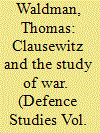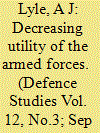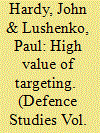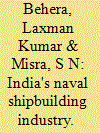| Srl | Item |
| 1 |
ID:
114618


|
|
|
|
|
| Publication |
2012.
|
| Summary/Abstract |
This article addresses the question to what extent the use of Non-Lethal Weapons (NLWs) in US internment centres between 2003 and 2009 was supportive to the hearts and minds approach in Iraq. It is argued that, other than claims and expectations of NLWs performance extracted from NLW technology and design properties, the performance and effects of NLWs heavily depend on the operational conditions in which they are applied. A Defence Technology Assessment (DTA) framework is applied to several cases in Iraqi detainee centres where NLWs have been used. The case studies demonstrate that in the absence of an acceptable political context in terms of a positive end state for the detainees, the use of NLWs to quell large scale disturbances was counterproductive. NLWs were as a necessary evil, rather than a benign force. Even with a constructive hearts and minds strategy to guide detainee operations in place, the skills and discipline of the guard forces are key to the successful conduct of detainee operations.
|
|
|
|
|
|
|
|
|
|
|
|
|
|
|
|
| 2 |
ID:
114614


|
|
|
|
|
| Publication |
2012.
|
| Summary/Abstract |
Carl von Clausewitz produced what is widely recognised as the greatest book on war. Less commonly appreciated is the nature of the approach he adopted which enabled him to arrive at his central theoretical conclusions. In the course of his studies Clausewitz confronted a number of central methodological dualisms. He believed the tensions inherent in these pairs could not be ignored and ultimately sought to reconcile their apparent contradictions through a dialectical process of intense reflection and study. Knowledge of such issues offers students of war and strategy a valuable methodology in coming to grips with such a vast and complex subject.
|
|
|
|
|
|
|
|
|
|
|
|
|
|
|
|
| 3 |
ID:
114615


|
|
|
|
|
| Publication |
2012.
|
| Summary/Abstract |
Clausewitz described the nature of war in terms of a trinity that could be associated to relationships between the armed forces, the government and society. This paper examines if this trinity is fundamentally affected by three current processes: the increasing use of civilians to supplement or replace military capabilities; the growing employment of unmanned systems; and the rapidly developing capabilities and potential of cyber-based operations. Each of these areas is considered in turn, highlighting how the processes bring about changes between the traditional roles in providing national security of the elements of Clausewitz's trinity. This paper concludes that the changes wrought by the processes of civilianisation, automation and cyber operations do pose significant challenges to the armed forces, but these are evolutionary rather than revolutionary. The wider issue is the increasing reliance of the government on private organisations and other nations to provide the full range of national security measures, and it is in these areas where much work is required to continue to assure security.
|
|
|
|
|
|
|
|
|
|
|
|
|
|
|
|
| 4 |
ID:
114616


|
|
|
|
|
| Publication |
2012.
|
| Summary/Abstract |
There is a common theme in literature about High-Value Targeting (HVT): that it does not work. In order to make an informed judgment on the use of HVT in irregular war against networked opponents, an accurate analytical framework is required. This article proposes a conceptual model that recognizes HVT as: subordinate to strategic objectives, a shaping and enabling tool, rather than a decisive tool, and fuelled by a robust, intelligence-led targeting cycle. It identifies three methods of conducting HVT: pressuring, leveraging, and desynchronizing, and argues that there is a significant and underappreciated potential for complementarity between HVT and non-kinetic operations in irregular warfare.
|
|
|
|
|
|
|
|
|
|
|
|
|
|
|
|
| 5 |
ID:
114617


|
|
|
|
|
| Publication |
2012.
|
| Summary/Abstract |
India has created a huge industrial base for naval warship construction. The growing capability of the industry is evident from its ability to construct major warships, including an aircraft carrier, destroyers, frigates and submarines. At the same time, there are certain weaknesses in the industry, which prohibit it from meeting the vast requirement of the maritime forces in the required timeframe and cost efficiently. Among others, the industry as a whole does not operate in a competitive environment, lacks crucial capability in warship design, and lacks civil-military integration for naval construction. Overcoming these challenges will be critical for creating a strong and vibrant naval shipbuilding industry in India.
|
|
|
|
|
|
|
|
|
|
|
|
|
|
|
|